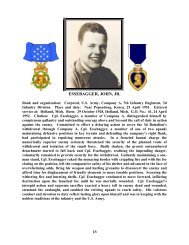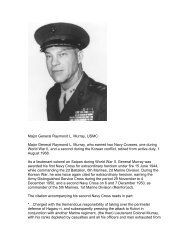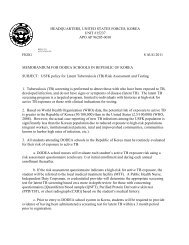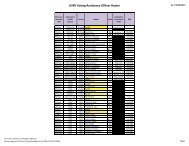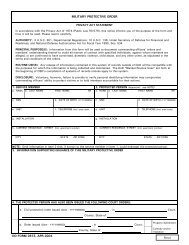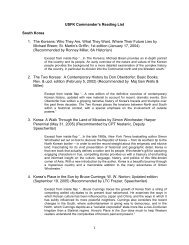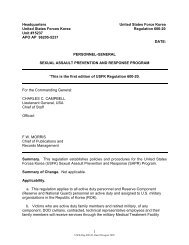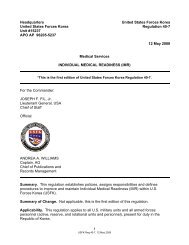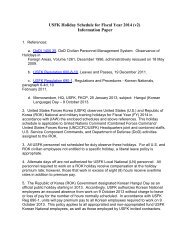Curtis Utz, Assault from the Sea, The Amphibious Landing, Naval ...
Curtis Utz, Assault from the Sea, The Amphibious Landing, Naval ...
Curtis Utz, Assault from the Sea, The Amphibious Landing, Naval ...
You also want an ePaper? Increase the reach of your titles
YUMPU automatically turns print PDFs into web optimized ePapers that Google loves.
Into <strong>the</strong> Gale<br />
Soon after <strong>the</strong> ships of<br />
Admiral Doyle’s amphibious<br />
armada put to<br />
sea <strong>from</strong> <strong>the</strong> ports of Kobe<br />
and Yokohama, Japan, <strong>the</strong>y<br />
faced age-old enemies, howling<br />
winds and raging waters.<br />
Navy wea<strong>the</strong>r planes and<br />
aerologists had warned Doyle<br />
days earlier that Typhoon<br />
Kezia was headed his way,<br />
which caused him to speed<br />
up <strong>the</strong> fleet’s loading and<br />
departure process. Hard work<br />
on <strong>the</strong> docks and on board<br />
<strong>the</strong> ships allowed <strong>the</strong> task<br />
force to sortie by 11 September,<br />
one day ahead of<br />
schedule. Doyle’s flagship,<br />
Mount McKinley (AGC 7),<br />
already being pounded by <strong>the</strong><br />
rising swell, was <strong>the</strong> last<br />
vessel to leave Kobe. Still,<br />
on <strong>the</strong> 12th, Kezia battered<br />
<strong>the</strong> fleet with 90-knot winds<br />
and massive waves. Doyle<br />
later described it as <strong>the</strong> worst<br />
storm he ever experienced.<br />
<strong>The</strong> tempest sorely tested<br />
<strong>the</strong> ships and sailors of <strong>the</strong><br />
flotilla. After losing her port<br />
engine, LST 1048 had to<br />
fight to maintain steerageway.<br />
<strong>The</strong> salvage ship<br />
Conserver (ARS 39) came<br />
alongside <strong>the</strong> struggling<br />
landing ship and floated<br />
down a hawser. Working on<br />
a wet, pitching deck, <strong>the</strong><br />
LST’s sea and anchor detail<br />
chocked <strong>the</strong> line into place<br />
and soon had secured a towing<br />
cable passed by Conserver.<br />
While only making six knots,<br />
<strong>the</strong> two ships proceeded toge<strong>the</strong>r<br />
and reached Inchon<br />
on time for <strong>the</strong> fight.<br />
On 12 September, Captain<br />
Norman <strong>Sea</strong>rs’s Advance<br />
Attack Group and three attack<br />
Navy Art Collection KN 19250<br />
<strong>The</strong> ships of Task Force 90 faced perilous seas, such as those depicted in Herbert<br />
Hahn’s “Heavy Wea<strong>the</strong>r,” as <strong>the</strong>y fought to make way during Typhoon Kezia.<br />
transports stood out of Pusan<br />
with <strong>the</strong> 5th Marines embarked.<br />
After a second<br />
Naktong Bulge battle, <strong>the</strong><br />
regiment barely had time to<br />
refit and integrate reinforcements<br />
<strong>from</strong> <strong>the</strong> United States.<br />
Before leaving Pusan, Marine<br />
leaders selected Lieutenant<br />
Colonel Robert D. Taplett’s<br />
3rd Battalion, 5th Marines,<br />
to make <strong>the</strong> initial assault<br />
on Wolmi Do.<br />
Meanwhile, Doyle’s Mount<br />
McKinley steered for Sasebo,<br />
Japan. <strong>The</strong>re, MacArthur<br />
Fast transport Wantuck (APD 125) and<br />
dock landing ship Comstock (LSD 19),<br />
loaded with Marines and <strong>the</strong>ir equipment,<br />
shape a course for Inchon.<br />
NA 80-G-423221



